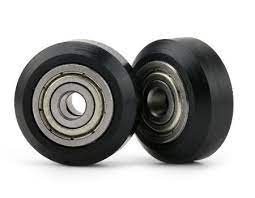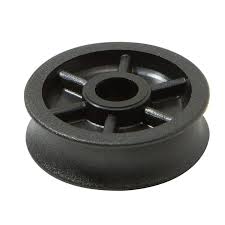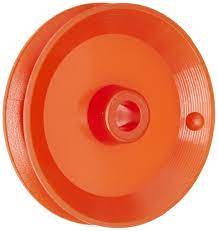Product Description
Plastic Pa66 Pulley with double bearing
Mc nylon, means monomer casting nylon, is a kind of engineering plastics used in comprehensive industries, has been applied almost every industrial field.
The caprolactam monomer is first melted, and added catalyst, then poured it inside moulds at atmosphere pressure so as to shape in different castings, such as: Rod, plate, tube. The molecule weight of mc nylon can reach 70, 000-100, 000/mol, 3 times than pa6/pa66. Its mechanical properties are much higher than other nylon materials, such as: Pa6/pa66. Mc nylon plays a more and more important role in the material list recommended by our country.
Since the end of 1980’s, HangZhou engineering plastics industireis company has devoting herself on developing the technology of mc nylon modification, greatly extended the applications in different industries. Basing on the mc nylon, reinforced with variety of additives during the reaction, such as lubricant, molybdenum disulfide, graphite glass fiber, carbon fiber etc, to improve the properties, higher performance of wear-resistance, corrosion-resistance, self-lubrication, vibration-absorption, noise-absorption. At the same time, as the technics and structure of the moulds is quite simple, so that it can be manufactured in lower cost, becomes the ideal substitutes of bronze, stainless steel, babbitt alloy, ptfe and so on.
Oil nylon (green)
Oil nylon(green)is the new engineering plastics that developed by HangZhou engineering plastics industireis company in the later 1980’s by importing the advanced technology from nylacast co., ltd, uk, was the first authentic lubricating nylon that builds the liquid lubricant system during the processing stage, which makes its coefficient of friction is 50% lower than the general pa6 or pa66, the wear-resistance is 10 times than the general ones. Oil nylon is specially developed for the parts of non-self-lubrication, heavy-loading and low-speed-running, which obviously resulted in a substantial increase in bearing life- 5 times that of general pa6 and 25 times that of phosphor bronze! The lubricant contained within the material will not drain, adsorb or dry out and never needs replenishment. The uniform distribution of the lubricant throughout the product guarantees the constant performance of the parts over the whole service life and improvements in rate of wear, sliding frictional properties, abrasion resistance and stick slip performance, which are just a few of the benefits offered by this material. Oil nylon has been successful in considerable enlarging the application of nylon in many industries and specifically for some un-lubricated running parts.
Other casting nylon:
Oil nylon + carbon (black)
Oil nylon added carbon, has the very compact and crystal structure, which is better than the general casting nylon in the performance of high mechanical strength, wear-resistance, anti-aging, uv resistance and so on. It is suitable for making the bearing and other wear mechanical parts.
Oil mc901(blue)
This improved mc nylon, has striking blue color, which is better than general pa6/pa66 in the performance of toughness, flexibility, fatigue-resistance and so on. It is the perfect material of gear, gear bar, transmission gear and so on.
Mc nylon + mso2(light black)
Mc nylon added mso2 can remain the impact-resistance and fatigue-resistance of casting nylon, as well as it can improve the loading capacity and wear-resistance. It has a wide application in making gear, bearing, planet gear, seal circle and so on.
| Property | Item No. | Unit | MC Nylon (Natural) | Oil Nylon+Carbon (Black) | Oil Nylon (Green) | MC90 (Blue) | MCNylon+MSO2(Light Black) | |
| Mechanical Properties | 1 | Density | g/cm3 | 1.15 | 1.15 | 1.135 | 1.15 | 1.16 |
| 2 | Water absorption (23ºCin air) | % | 1.8-2.0 | 1.8-2.0 | 2 | 2.3 | 2.4 | |
| 3 | Tensile strength | MPa | 89 | 75.3 | 70 | 81 | 78 | |
| 4 | Tensile strain at break | % | 29 | 22.7 | 25 | 35 | 25 | |
| 5 | Compressive stress (at 2%nominal strain) | MPa | 51 | 51 | 43 | 47 | 49 | |
| 6 | Charpy impact strength (unnotched) | KJ/m 2 | No brak | No break | ≥50 | No BK | No break | |
| 7 | Charpy impact strength (notched) | KJ/m 2 | ≥5.7 | ≥6.4 | 4 | 3.5 | 3.5 | |
| 8 | Tensile modulus of elasticity | MPa | 3190 | 3130 | 3000 | 3200 | 3300 | |
| 9 | Ball indentation hardness | N/mm 2 | 164 | 150 | 145 | 160 | 160 | |
| 10 | Rockwell hardness | – | M88 | M87 | M82 | M85 | M84 | |
/* January 22, 2571 19:08:37 */!function(){function s(e,r){var a,o={};try{e&&e.split(“,”).forEach(function(e,t){e&&(a=e.match(/(.*?):(.*)$/))&&1
| Material: | PA |
|---|---|
| Size: | According to Drawing or Sample |
| Color: | Natural, White, Black, Green, Blue |
| Tooling: | CNC Lathe |
| Transport Package: | Packing in Paper Carton and Wooden Pallet |
| Specification: | RoHS |
| Customization: |
Available
| Customized Request |
|---|
What are some real-world examples of plastic pulley applications in different industries?
Plastic pulleys find a wide range of applications across various industries. Here are some real-world examples:
1. Fitness and Exercise Equipment:
In the fitness and exercise industry, plastic pulleys are commonly used in cable machines, functional trainers, and other resistance training equipment. They provide smooth and controlled movement of cables, enabling users to perform a variety of exercises targeting different muscle groups. Plastic pulleys contribute to the functionality and versatility of gym equipment, enhancing the overall workout experience.
2. Material Handling and Conveyor Systems:
Plastic pulleys are utilized in material handling and conveyor systems to facilitate the movement of goods, packages, or materials. They can be found in industries such as manufacturing, logistics, warehousing, and distribution centers. Plastic pulleys help guide and redirect conveyor belts, ensuring efficient and reliable transportation of products along the production or distribution line.
3. Automotive Industry:
The automotive industry employs plastic pulleys in various applications. They are commonly used in engine systems, such as timing belt systems, accessory belt drives, and serpentine belt systems. Plastic pulleys provide reliable power transmission and help drive auxiliary components, such as water pumps, alternators, air conditioning compressors, and power steering pumps. They contribute to efficient engine operation and overall vehicle performance.
4. Agricultural Machinery:
In the agricultural sector, plastic pulleys are utilized in machinery and equipment used for farming operations. They are often found in equipment such as combine harvesters, hay balers, crop sprayers, and seeders. Plastic pulleys help drive and control the movement of belts and chains, enabling the efficient operation of various agricultural processes and facilitating tasks like harvesting, baling, spraying, and seeding.
5. Industrial Automation:
Plastic pulleys play a role in industrial automation systems, especially in applications that require precise motion control. They can be found in robotics, CNC machines, printing machinery, packaging equipment, and other automated systems. Plastic pulleys provide accurate and smooth movement, contributing to the precision and reliability of these automated processes.
6. Medical Devices:
In the medical industry, plastic pulleys are used in various medical devices and equipment. They find application in devices such as surgical robots, rehabilitation equipment, patient lifts, and diagnostic machines. Plastic pulleys enable controlled movement and positioning in these medical devices, aiding in surgical procedures, patient mobility, and diagnostic imaging.
7. Textile Industry:
Plastic pulleys are employed in textile manufacturing processes. They are used in machinery for spinning, weaving, knitting, and other fabric production operations. Plastic pulleys help guide and tension the threads or yarns, ensuring smooth and consistent movement during the textile manufacturing process.
8. Entertainment Industry:
In the entertainment industry, plastic pulleys can be found in equipment used for stage rigging, lighting, and sound systems. They assist in the movement and suspension of stage elements, lighting fixtures, and audio equipment. Plastic pulleys provide reliable and smooth operation, facilitating the setup and operation of various events and performances.
These are just a few examples of how plastic pulleys are used in different industries. Their versatility, durability, and cost-effectiveness make them a popular choice for numerous applications where smooth and controlled movement is required.
What maintenance procedures are necessary to ensure the reliability of plastic pulleys?
To ensure the reliability of plastic pulleys, several maintenance procedures should be followed. Here’s a detailed explanation:
1. Regular Inspection:
Regular inspection is crucial for identifying any signs of wear, damage, or degradation in plastic pulleys. Inspect the pulleys periodically to check for cracks, excessive wear, or any other visible issues. Pay attention to the pulley’s grooves, edges, and mounting points. If any damage is detected, the pulley should be replaced promptly to prevent unexpected failures or accidents.
2. Lubrication:
Appropriate lubrication is important to ensure the smooth operation and longevity of plastic pulleys. Follow the manufacturer’s recommendations for lubrication intervals and the type of lubricant to be used. Apply lubricant to the pulley’s bearings or bushings as specified. Proper lubrication reduces friction, minimizes wear, and helps maintain the pulleys’ performance and reliability.
3. Cleaning:
Clean plastic pulleys regularly to remove dirt, dust, or debris that may accumulate on the surface. Use a soft brush or cloth to gently clean the pulleys, ensuring that no abrasive materials or harsh chemicals are used that could damage the plastic material. Clean pulleys help prevent contaminants from entering the system and interfering with the pulley’s movement or the overall performance of the equipment.
4. Belt or Chain Tension:
Check and adjust the tension of belts or chains connected to plastic pulleys. Proper tension is crucial for efficient power transmission and to prevent slippage. Follow the manufacturer’s guidelines to determine the correct tension for the specific application. Ensure that the belts or chains are not too loose or too tight, as both conditions can lead to premature wear or failure of the pulleys.
5. Alignment:
Proper alignment of plastic pulleys is essential for their reliable operation. Misalignment can cause excessive vibrations, premature wear, and increased stress on the pulleys and associated components. Regularly check the alignment of the pulleys and make any necessary adjustments. Follow the manufacturer’s recommendations for alignment procedures to ensure optimal performance and longevity of the pulleys.
6. Environmental Considerations:
Consider the environmental conditions in which the plastic pulleys are operating. Extreme temperatures, exposure to chemicals, or other harsh conditions can impact the pulley’s reliability and lifespan. If the environment poses specific challenges, choose plastic pulleys that are resistant to the prevailing conditions. For example, select pulleys made from materials with high-temperature resistance or chemical resistance, as required.
7. Manufacturer’s Guidelines:
Always refer to the manufacturer’s guidelines and recommendations for maintenance procedures specific to the plastic pulleys being used. Manufacturers often provide detailed instructions on inspection, lubrication, cleaning, and other maintenance tasks. Adhering to these guidelines ensures that the maintenance procedures are carried out correctly and in accordance with the manufacturer’s specifications, maximizing the reliability and lifespan of the plastic pulleys.
By following these maintenance procedures, operators can ensure the reliability and longevity of plastic pulleys. Regular inspection, proper lubrication, cleaning, belt or chain tensioning, alignment, considering environmental factors, and adhering to manufacturer’s guidelines are all vital in maintaining the optimal performance of plastic pulleys in various industrial applications.
What types of belts or cables are typically employed with plastic pulleys?
Plastic pulleys are designed to work in conjunction with different types of belts or cables, depending on the specific application and requirements. Here’s a detailed explanation of the types of belts or cables that are typically employed with plastic pulleys:
1. Timing Belts:
Timing belts, also known as synchronous belts, are commonly used with plastic pulleys. Timing belts have evenly spaced teeth on the inner surface, which engage with corresponding teeth on the plastic pulleys. This toothed design allows for precise power transmission and synchronized movement in applications that require accurate positioning or timing, such as in automotive engines or industrial machinery.
2. V-Belts:
V-belts, also called Vee belts, are frequently employed with plastic pulleys. V-belts have a trapezoidal cross-section and rely on friction between the belt and the pulley groove to transmit power. The angled sides of the V-belt fit into the corresponding V-shaped grooves on the plastic pulleys, providing reliable power transfer. V-belts are commonly used in applications such as HVAC systems, industrial machinery, and automotive accessory drives.
3. Flat Belts:
Flat belts, as the name suggests, have a flat surface and are often used with plastic pulleys. They rely on friction between the belt and the pulley surface to transmit power. Flat belts are versatile and find applications in various industries, including packaging machinery, material handling systems, and printing presses. Plastic pulleys with a flat surface are designed to provide optimal grip and traction for effective power transmission with flat belts.
4. Round Belts:
Round belts, also known as round o-ring belts or endless belts, are circular belts without any visible seam or splice. They are commonly utilized with plastic pulleys that have rounded grooves or flanges. Round belts are flexible and can be easily threaded through a system of pulleys, making them suitable for applications such as conveyor systems, packaging machinery, and small appliances.
5. Cable Systems:
Plastic pulleys are also employed with various types of cables in certain applications. Cable systems, such as wire rope or cables with an outer protective coating, may be guided or routed through plastic pulleys to achieve controlled movement or tensioning. These cable systems find applications in industries such as construction, material handling, and transportation.
6. Other Specialty Belts:
In addition to the commonly used belts mentioned above, plastic pulleys can be employed with other specialty belts based on specific requirements. For example, polyurethane belts, round tooth belts, or specialty conveyor belts may be used in applications where higher load capacity, chemical resistance, or specialized functionality is needed.
In summary, plastic pulleys can be paired with various types of belts or cables, including timing belts, V-belts, flat belts, round belts, cable systems, and other specialty belts. The choice of belt or cable depends on factors such as the application, power transmission requirements, desired accuracy, and environmental conditions. Plastic pulleys are designed to provide optimal engagement, grip, and traction for the specific type of belt or cable, ensuring efficient and reliable power transmission in a wide range of industries and applications.
editor by CX
2024-05-08




